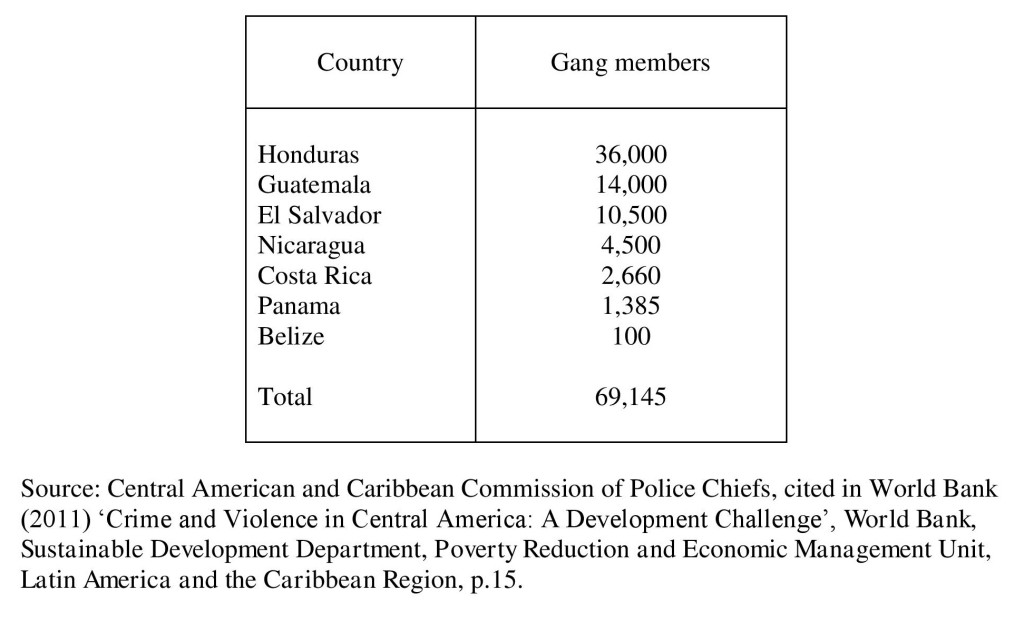
Category: The scale and nature of present day violence
Violent deaths and extrajudicial executions in Honduras, children and youth, 1998 – 2011
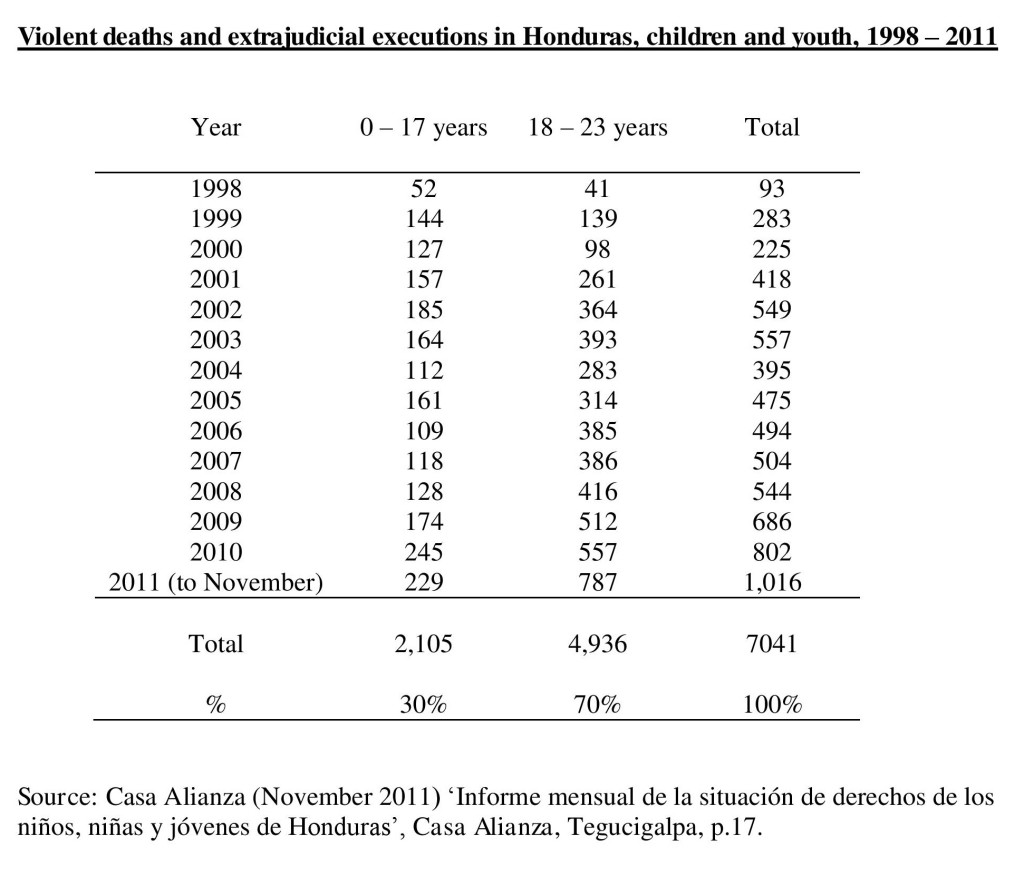
Facussé threatens human rights activists, beheads peasants
04/26/2011 | AP
If you are wondering, dear reader, why I didn’t post on last week’s assassinations, including beheadings, it was because I simply could not handle it. It’s no excuse, the campesinos in Aguán aren’t backing off. But sometimes even the secondhand trauma is too much. It’s one of those dilemmas of violence research- one’s own pain is voluntary, in a sense, and thus cannot be legitimately compared to the pain of those who are experiencing the evident, immediate trauma (except within a theoretical framework of a violence continuum, using a million caveats). But perhaps my twisted gut, this sense of nausea and impotence can provide some small insight, even thousands of miles away, into the terror embodied by those facing the barrels of Facussé’s assassins’ guns.
In any case, when he’s not busy ordering the murders of campesinos who get in the way of the WWF-eco-certified African Palms he has on the lands he stole from them, Facussé, who has admitted on national television that his guards kill peasants (and yet has never been investigated by the government for his role in these murders) is now fighting back. Tired of people calling him out, he took out a full-page ad in La Tribuna to publicly denounce/threaten the human rights defenders who have affected the only thing he cares about- his profits. What’s really astounding—and not just speaks, but shouts to the level of US-backed impunity in Honduras—is that, in order to personalize this threat against his opponents, he not only names them, but quotes exactly what they have to say about him, just as unapologetically as he admitted to doing exactly what many of them accuse him of- murdering campesinos. The ad, included below as an image, reads as follows:
To the Honduran Nation and International Community:
We write here to inform you that we are being subjected to a smear campaign using false accusations of national and international NGOs. Said campaign has the aim of destroying over 50 years of work to provide Hondurans and Central Americans with products of the highest quality, investments in the billions of lempiras, the creation of more than 8,000 direct jobs, the generation of more than US$100 million in profits annually, and the creation of more than 100 thousand indirect jobs.
The most recent campaign is aimed at blocking the certification of the company by the UN for the sale of carbon credits for the development and implementation of clean energy projects and projects for environmental conservation; to stop international financial institutions from financing our companies, thus putting at risk the investment so desperately needed by the country and finally to promote the boycott of our products.
We ask you all to not be fooled by these people and groups that denounce us internationally irresponsibly and with sinister intent, not only with the aim of destroying the hard work of thousands of Hondurans and Central Americans in making the Dinant Group what it is today, but also of undermining the environment for investment and development in Honduras.
We call upon the corresponding Honduran authorities to investigate what we have stated here.
To the Honduran nation and international community, we reiterate here our commitment to continue helping the development of the country, through business practices committed to the conservation of the environment and through proper corporate social responsibility.
Miguel Facussé Barjum, President, Dinant Corporation/ Exporter of the Atlantic
“To affect [his/its] business, profits and image is an important tactic, and we will do whatever we can to ensure that these projects do not continue receiving funding”,
said to Sirel the representative of FIAN Honduras, Ana María Pineda
“We, Artists in Resistance, Feminists in Resistance, and many allied groups along with the youth, have a boycott campaign against the products of Miguel Facussé”…
Karla Lara, of Artists and Feminists in Resistance of Honduras
As such, the decision to launch a boycott campaign against the products of the Dinant Corporation means joining together the desire of thousands of Hondurans who want to deal a blow to the economic and political power of Miguel Facussé, one of the leading exponents of this structure”
Lorena Zelaya, member of the FNRP
Miguel Facussé is “an assassin and thief straight out of Hell” who will “make himself owner of the entire country using the same methods he uses here”:
Father Fausto Milla, in relation to Zacate Grande
“The soldiers and police are commanded by Miguel Facussé, despite the fact that they are paid by the Honduran people, but they obey the orders of the de facto powers that have taken control of the nation”.
Bertha Oliva, COFADEH
“Save the Rainforest makes an urgent call to send a message to the British government to withdraw authorization from these two projects that will directly benefit Miguel Facussé Barjum, repeatedly indicated by campesinos organizations to be the primary individual responsible for the violence and violation of human rights in the Bajo Aguán”.
Save the Rainforest, German NGO in relation to the projects of carbon credit sales
“the loans that are being provided to this man [Facussé], who has become the number one criminal in Latin America, for now, with the ability of mobilizing an army that at this moment, openly patrols the streets of the Aguán, in Tocoa and in Trujillo, carrying out acts of terror in the numerous cooperatives in the palm agrarian sector in the Aguán”.
Andrés Pavon, CODEH
What I have seen is outrageous and Facussé is a criminal”
Mirna Perla, Salvadoran judge and member of the parallel True Commission set up by the FNRP
We have confirmed the lack of seriousness of the Attorney General and a generalized dissatisfaction in the region, which could lead to a dangerous increase in conflict. Furthermore—explained the leadership of FIAN International—, international standards are not being applied with regards to evictions. They are premeditated violent acts, without legal backing, and represent crystal-clear violations of human rights”,
Central American coordinator of FIAN International, Martin Wopold Bosien.
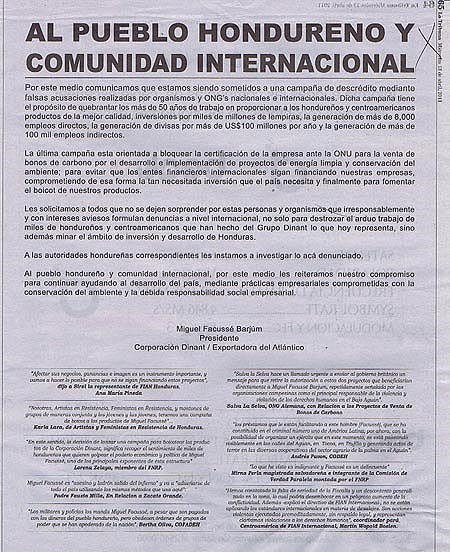
Quotha content by Adrienne Pine is licensed under a Creative Commons Attribution-Noncommercial-No Derivative Works 3.0 United States License.
CISPES Supports Human Rights Defender in Face of Death Threats
Sent: 26 January 2010 09:01 by Committee in Solidarity with the People of El Salvador (CISPES)
CISPES would like to express our heartfelt solidarity with El Salvador’s Human Rights Ombudsman, Oscar Luna, who announced last Thursday, January 21 [2010] that he and his family have been receiving death threats. Luna declared that the threats have been delivered in the name of supposed extermination groups, demanding that he leave the country within 48 hours so as to not “obstruct the work of social cleansing” that they are attempting to carry out against “delinquency.” The re-emergence of such “social cleansing” groups was previously denounced by former Human Rights Ombudswoman Beatrice de Carrillo in 2006.
Oscar Luna has been an outspoken advocate for human rights in El Salvador. He defended the Suchitoto 13, water privatization protesters who were charged under the anti-terrorism law and denounced electoral fraud by ARENA during the 2009 elections. Most recently, he has pushed the Attorney General’s office to investigate the intellectual authors of the murders of Marcelo Rivera, Ramiro Rivera and Dora Alicia Sorto Recinos and mobilized his office to provide protection for environmental activists in Cabañas. He has decided not to leave his post, nor to leave the country. Instead, he is calling on the Attorney General and the head of the National Civilian Police to investigate and to provide additional protection for him and his family.
On January 16, El Salvador celebrated the 18th anniversary of the Peace Accords, when much of the State’s repressive apparatus was formally dismantled. However, the re-emergence of death squad structures, and the continued death threats against and assassinations of social movement activists, FMLN leaders and human rights defenders, represent a terrifying roll-back in the struggle for real democracy. CISPES stands with Mr. Luna in defending his position and in continuing his important work of promoting human rights in El Salvador and we call on the Attorney General’s office and the National Civilian Police to do everything within their power to protect Mr. Luna and all others in the struggle for justice in El Salvador.
Honduran environmentalists under threat
The following article was included in the January 2008 ENCA Newsletter (no.44) as a report on a summer 2007 ENCA study tour of Honduras.
By Martin Mowforth
ENCA’s 2007 environmental study tour of Honduras met with our Honduran counterparts who work in a range of grassroots socio-environmental organisations there. We met and spent several days with members of the Fundación Prolansate, the Olancho Environmental Movement (MAO), the Civic Council of Popular and Indigenous Organisations of Honduras (COPINH) and the International Centre for Information on Cover Crops (CIDICCO). With several members of these organisations we also attended the launch of an Amnesty International report on ‘Persecution and Resistance: The experience of human rights defenders in Guatemala and Honduras’.
Even before our involvement with Amnesty International, it is no exaggeration to say that we had been shocked by the level of danger suffered by our Honduran counterparts in these organisations. Had we been aware of this beforehand, we would have allowed ourselves at least a couple of days after each of our visits to these organisations to absorb the reality of the threats they have to live with. A little background may be helpful to explain the situation our partner organisations face, along with a few details of some of the assassinations which have already occurred and the threats currently faced.
In the 1980s, whilst wars raged around Honduras, the country became known as USS Honduras for its role in harbouring, training and supplying the contras in Nicaragua. In that decade it developed its own death squads – like most of the death squads in Latin America, they were inspired and trained, overtly and covertly, by branches of the US government – to snuff out dissent and opposition within its own borders.
The peace accords and the end of the wars fought in the territories of its three neighbours (Guatemala, El Salvador and Nicaragua) did not exactly bring an end to the activities of the death squads in Honduras. The political targets were replaced by those deemed appropriate for a spot of social cleansing – street children and vagrants. Casa Alianza (a street childrens’ organisation which works in a number of Central American capital cities) reports the violent deaths and arbitrary executions of 3,395 children and youths from 1998 to 2006 (inclusive)[1] – a systematic form of genocide, or as Casa Alianza calls it “a selective policy of extermination”.
But the death squads also began to make themselves available for other targets, one of which was provided by environmentalists and social activists who were leading protests against the indifference, disruption, dislocation and contamination caused by commercial activities and so-called development projects. Since the assassination of Jeannette Kawas in 1995, environmentalists in Honduras have been a major target for the death squads.
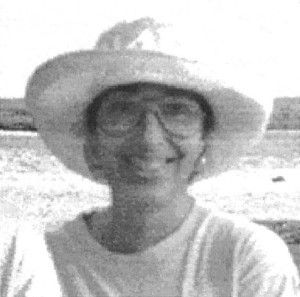 Jeannette Kawas (pictured) was the President of Fundación Prolansate, an environmental and conservation organisation which has the responsibility for the care of a number of protected areas on the northern coast of Honduras around Tela Bay. It was as a result of her work that these areas were granted stronger protection by the Honduran state and that a large area around Punta Sal was awarded the status of a National Park. But this work did not please everyone, and the advances made during her presidency of Prolansate were seen as obstacles to the development of a number of business projects. The organisation was involved in campaigns against transnational companies which were deforesting and polluting the local environment. It was also involved in a local controversy which approved the movement of landless campesinos (supported by the Honduran Ministries of Agriculture and Tourism) into areas under Prolansate’s protection. Moreover, the area was seen as ripe for tourism investment, and land purchases by interested companies and individuals (even without the construction of tourism infrastructure) had already forced up land values and converted the area into a source of capital accumulation.
Jeannette Kawas (pictured) was the President of Fundación Prolansate, an environmental and conservation organisation which has the responsibility for the care of a number of protected areas on the northern coast of Honduras around Tela Bay. It was as a result of her work that these areas were granted stronger protection by the Honduran state and that a large area around Punta Sal was awarded the status of a National Park. But this work did not please everyone, and the advances made during her presidency of Prolansate were seen as obstacles to the development of a number of business projects. The organisation was involved in campaigns against transnational companies which were deforesting and polluting the local environment. It was also involved in a local controversy which approved the movement of landless campesinos (supported by the Honduran Ministries of Agriculture and Tourism) into areas under Prolansate’s protection. Moreover, the area was seen as ripe for tourism investment, and land purchases by interested companies and individuals (even without the construction of tourism infrastructure) had already forced up land values and converted the area into a source of capital accumulation.
Jeannette Kawas was assassinated in February 1995, and still nobody has been brought to justice for the crime. Despite all the possible sources of violence given above, it is currently believed that the intellectual author of the crime was Jorge Montoya who had sold land for logging, the permit for which was cancelled by AFE-COHDEFOR, the state Forestry Commission, under Jeannette Kawas’ prompting and local management.
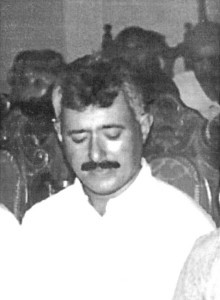 Carlos Escaleras (pictured) was assassinated in October 1997. Throughout the 1990s Carlos coordinated the efforts and campaigns of COPA, the Coordinating Body of Popular Organisations of Aguán, and in this role he often found himself and the organisation protesting about the contamination caused by a palm oil extraction plant owned by Miguel Facussé, a rich and powerful businessman and nephew of a former President of Honduras. Amongst others, Facussé has been accused of the intellectual authorship of the assassination of Carlos, but “the parliamentary immunity of some, the economic, political and military power of others and the complicity of judges and magistrates have been the obstacles to justice; as a result of these, the intellectual authors and material assassins have remained wrapped in impunity”[2].
Carlos Escaleras (pictured) was assassinated in October 1997. Throughout the 1990s Carlos coordinated the efforts and campaigns of COPA, the Coordinating Body of Popular Organisations of Aguán, and in this role he often found himself and the organisation protesting about the contamination caused by a palm oil extraction plant owned by Miguel Facussé, a rich and powerful businessman and nephew of a former President of Honduras. Amongst others, Facussé has been accused of the intellectual authorship of the assassination of Carlos, but “the parliamentary immunity of some, the economic, political and military power of others and the complicity of judges and magistrates have been the obstacles to justice; as a result of these, the intellectual authors and material assassins have remained wrapped in impunity”[2].
Carlos Antonio Luna (pictured left) was assassinated in May 1998 at the age of 42. He fought against illegal timber felling in the region of Catacamas in the department of Olancho and exposed those responsible for it. In April he received death threats, and he left with COFADEH (the Honduran Committee of Families of the Detained and Disappeared) a note to say that if anything happened to him, the intellectual authors of the threats were Lincoln Figueroa, a nationalist deputy who, it was known, had already remarked that only killing Carlos Luna would solve th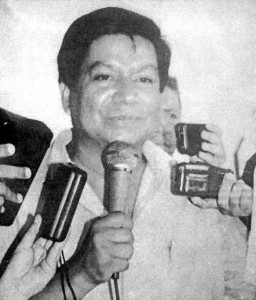 eir problems; Jorge Chávez, a timber merchant; José Angel Rosa, another timber merchant who had repeatedly threatened Carlos with death; and the Soto family who were involved in the illegal exploitation and trafficking of timber. Jorge Chávez was captured in 2002 and served four years in jail, gaining his freedom in 2006. The other intellectual authors remain free. The material assassin Oscar Rodríguez is currently serving a 27 year sentence for the crime.
eir problems; Jorge Chávez, a timber merchant; José Angel Rosa, another timber merchant who had repeatedly threatened Carlos with death; and the Soto family who were involved in the illegal exploitation and trafficking of timber. Jorge Chávez was captured in 2002 and served four years in jail, gaining his freedom in 2006. The other intellectual authors remain free. The material assassin Oscar Rodríguez is currently serving a 27 year sentence for the crime.
Carlos Roberto Flores (pictured right) was 28 when he was assassinated in June 2001. He paid with his life for his opposition to the Babilonia hydroelectric project. Six security guards of Energisa, the company responsible for the project, are accused as material perpetrators of the crime – three of them have been detained and three have fled. Accused as intellectual authors of the crime is Héctor Julián Borjas Rivera, President of the Energisa company, which had received a $270 million loan from the Central American Bank of Economic Integration (BCIE) for the project. He has not been arrested.
José Mauricio Hernández Cáceres was assassinated in November 2002. He was killed because of his public opposition to illegal logging in Olancho. In 2004, Alexis Días Cáceres was sentenced to 20 years in prison for committing the crime with two accomplices who were given lesser sentences. Within the communities in Olancho in which José was known, it is widely believed that the intellectual authors of the assassination are Rúben Antúnez (a cattle rancher), Francisco Zúñiga (mayor of the commun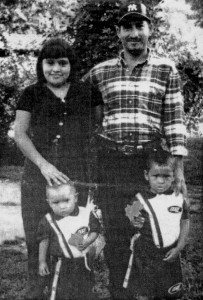 ity of Jano and an exploiter of the local forest timber) and Juan Lanza (a timber merchant).
ity of Jano and an exploiter of the local forest timber) and Juan Lanza (a timber merchant).
Carlos Arturo Reyes (pictured below left)Carlos Arturo Reyes (pictured right) was 23 years old when he was assassinated in July 2003. After the March For Life in 2003, his name appeared on a death list of environmentalists to be assassinated. Carlos’s brother, Francisco Nahín Reyes Méndez, is believed to be responsible for the assassination. Francisco is known for his violent character and is also believed to have killed his girlfriend. It is thought that he was used by the logging companies to carry out this crime, after which he fled to the USA. But he returned several months later and is still at large in Honduras.
In December 2006, two members of the Environmental Movement of Olancho (MAO by its Spanish initials), Heraldo Zúñiga and Roger Iván Cartagena, were shot dead in the town of Guarizama, in Olancho. They were killed in execution style b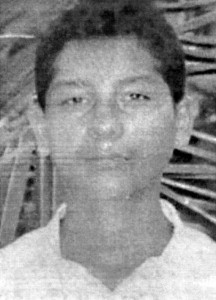 y four members of the national police who are now in custody. The MAO has consistently campaigned against illegal logging in Olancho department since the year 2000 and has not been afraid to name the names of those responsible and to denounce corrupt officials of COHDEFOR, the Honduran Forestry Development Commission, which issues permits for felling. In May 2006 Heraldo Zúñiga stated that he had received several death threats after publicly exposing cases of illegal logging in the west of the department. That same month the Inter-American Commission on Human Rights (IACHR) requested information about this case from the Honduran government, which implemented protective measures for Padre Andres Tamayo, leader of the MAO. No protective measures for other members of the MAO were implemented. After the executions of the two MAO members in December 2006, the IACHR ordered the Honduran government to provide protection for other members of the MAO, but as ENCA members discovered during their visit in August 2007, no such protection has yet been provided.
y four members of the national police who are now in custody. The MAO has consistently campaigned against illegal logging in Olancho department since the year 2000 and has not been afraid to name the names of those responsible and to denounce corrupt officials of COHDEFOR, the Honduran Forestry Development Commission, which issues permits for felling. In May 2006 Heraldo Zúñiga stated that he had received several death threats after publicly exposing cases of illegal logging in the west of the department. That same month the Inter-American Commission on Human Rights (IACHR) requested information about this case from the Honduran government, which implemented protective measures for Padre Andres Tamayo, leader of the MAO. No protective measures for other members of the MAO were implemented. After the executions of the two MAO members in December 2006, the IACHR ordered the Honduran government to provide protection for other members of the MAO, but as ENCA members discovered during their visit in August 2007, no such protection has yet been provided.
The litany of assassinations could continue, but space prevents it. Today’s most pressing concern is the list of those currently living under threat of death or of persecution and prosecution by the authorities acting upon accusations made by the illegal loggers and companies whose operations they oppose. Those under threat of death include those listed after the first March For Life in June 2003, when thousands of people walked more than 170 km from Juticalpa in Olancho department to Tegucigalpa to demand an end to the illegal timber operations in Olancho. The march was headed by Padre Andres Tamayo, the priest in the town of Salamá, who now has a permanent bodyguard of Honduran soldiers because of the death threats he has received. Padre Andres drove us around various parts of Olancho to show us the deforestation, the areas where the MAO and local communities have blockaded roads to stop the loggers, the places where unarmed local residents have experienced tense stand-offs against hired gangs armed with AK-47s and Uzis. But what disturbs members of the MAO most is the threats faced by other members of the MAO who have no bodyguards and no protection despite the IACHR’s instructions to the Honduran government. Recent history shows that the threats are not idle. The logging companies and all those who profit from the operation will stop at nothing to ensure the profits they gain from selling their timber to the USA and Europe[3].
[1] Casa Alianza UK Newsletter, February 2007. 35 per cent (1,193) of these were children under the age of 18.
[2] Comité de Familiares de Detenidos-Desaparecidos en Honduras (COFADEH) (2006) Erguidos Como Pinos: Memoria sobre la construcción de la conciencia ambientalista, Tegucigalpa, page 48.
[3] Environmental Investigation Agency (EIA) (2005) ‘The Illegal Logging Crisis in Honduras: How US and EU imports of illegal Honduran wood increase poverty, fuel corruption and devastate forests and communities’. The report is available from the EIA’s website: www.eia-international.org
Gunmen Kill 2 Journalists in Southern Town in Guatemala
Posted by: This reporter has chosen to remain anonymous.
Date: 10 March 2015
Location: Zona 1, Mazatenango, Guatemala
Description of Event: Gunmen shot and killed two journalists and wounded a third Tuesday as they walked in a park in southern Guatemala, the editor of Prensa Libre newspaper said.
Danilo Lopez, the local correspondent for Prensa Libre, and Federico Salazar, of Radio Nuevo Mundo, were killed in a park in Mazatenango municipality.

The men were the vice-president and secretary, respectively, of the recently created Suchitepequez Press Association, according to Centro Civitas, a nonprofit organization dedicated to journalists’ human rights.
Prensa Libre editor Miguel Angel Mendez Zetina said Lopez had worked at the paper for more than a decade and recently filed a complaint against Jose Linares Rojas, the mayor of San Lorenzo, for making death threats against him. Lopez had written stories about the lack of transparency surrounding public funds in Linares’ administration, the editor added.
“Two mayors from Mazatenango municipality had threatened him for his stories,” Mendez said. “Danilo was a very ethical reporter, very transparent and he was very good at accounting for public funds and how this impacted communities.”
Marvin Robledo, director of Radio Nuevo Mundo, said Salazar had not mentioned any problems or threats and was not working on anything special when he was killed.
“We’re going to await the investigations, we don’t know the motive,” Robledo said.
Lopez’s family said he had also been threatened recently by Julio Juarez, the former mayor of Santo Tomas La Union, who had left his post to become a congressional deputy candidate, according to a statement from the press association.
 Local volunteer firefighters said a third man, Marvin Tunches, was taken to a hospital in serious condition. The press association said Tunches was a reporter for a local cable channel and requested protection for him.
Local volunteer firefighters said a third man, Marvin Tunches, was taken to a hospital in serious condition. The press association said Tunches was a reporter for a local cable channel and requested protection for him.
Local prosecutors announced through their Twitter account the capture of a suspect in the attack.
During the current government, four journalists have been killed in the Suchitepequez department. Investigators have received 20 complaints about aggression toward journalists so far this year.
Miguel Gonzalez Moraga of Centro Civitas, said that while President Otto Perez Molina announced a program in November 2014 to protect journalists, so far no related actions have been made public.
This report first appeared on 1voz.org
María Santos Domínguez
On 5 March 2014, as human rights defender Ms María Santos Domínguez returned to her home, she was surrounded and attacked with sticks, stones and machete by a group of seven individuals. Her husband and her son came to her rescue but were also attacked, with her son losing his ear. María Santos Domínguez has faced death threats on repeated occasions.
She is the co-ordinator of the Organización del Consejo Indígena del Río Blanco y del Sector Norte de Intibucá (Indigenous Coucil of Río Blanco and the North of Intibucá). The human rights defender is also a member of the Consejo Cívico de Organizaciones Indígenas y Populares de Honduras – COPINH (Civic Council of Popular and Indigenous Organisations of Honduras) and an emblematic leader in the struggle for the defence of the Gualcarque river and the indigenous Lenca territory. Her husband, Mr Santos Roque Domínguez, is also a member of COPINH and a community activist.
On 5 March, just after noon, María Santos Domínguez was returning from preparing school lunches, on the route she normally uses. Santos Roque Domínguez phoned her several times due to the worry caused by the threats already made against the human rights defender. On the fourth call, María Santos Domínguez informed her husband that seven individuals, allegedly the same who had threatened her with death, and who had been waiting for her on her route, had her surrounded. In that moment, her husband and son left the house to search for her and found her, having already received deep machete wounds, being beaten with sticks and stones by the group. Santos Roque Domínguez tried to reason with them and pleaded with them not to kill his wife, meanwhile his son attempted to aid his mother. Immediately, one of the group slashed the child with the machete, chopping off his right ear and part of his face. Santos Roque Domínguez was also gravely injured. The attack against the three family members has left them in a serious state of health.
María Santos Domínguez, as well as her husband and son, have been the target of serious threats and attacks because of their work in opposition to the Agua Zarca hydroelectric plant. The same group who attacked them on 5 March also destroyed their crops on a previous occasion.
Honduras is one of the most dangerous countries in the world to be a human rights defender, owing to threats, defamation, judicial harassment, physical attacks, attempted killings and killings. Indigenous leader and member of COPINH, Mr Justo Sorto was killed on 21 January 2014. Human rights defender Mr Tomás García was killed on 15 July 2013, and the case has still not been properly investigated.
Front Line Defenders roundly condemns the attempt on the life of human rights defender María Santos Domínguez, as well as the attack on her husband and son. Front Line Defenders considers the attack to be directly related to the peaceful and legitimate work of María Santos Domínguez and the Organización del Consejo Indígena del Río Blanco y del Sector Norte de Intibucá.